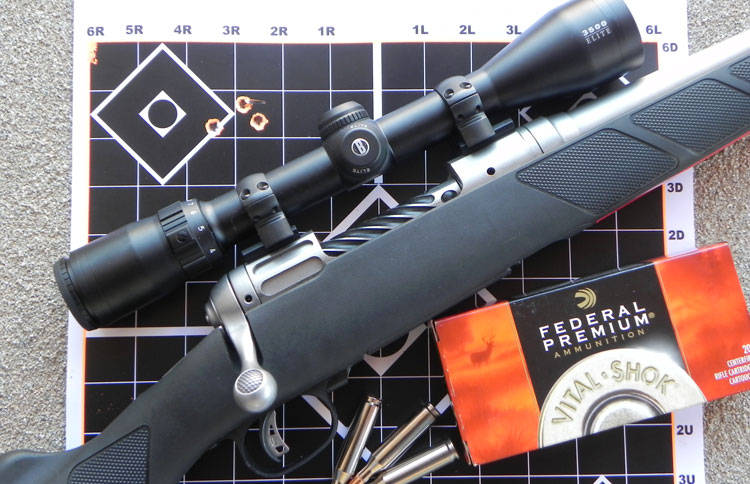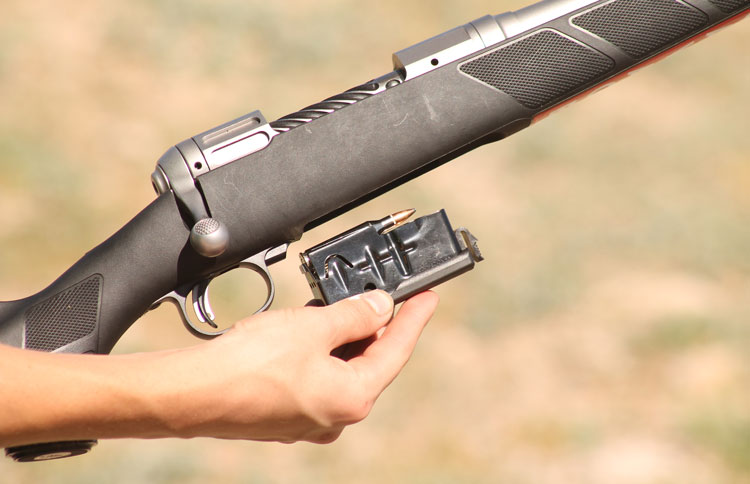Something lighter is not always something better, as you trade off such things as stability for less weight, and lighter guns simply kick harder. Lighter guns are also more difficult to shoot accurately because under recoil they can move a lot during the bullet’s dwell time in the bore. They also typically have thinner barrels that heat up more easily and start stringing shots over extended shooting sessions. However, those issues aren't a problem with the new Savage Arms Model 16 Lightweight Hunter.
The Model 16 Lightweight Hunter, part of Savage's Specialty Series, is for hunters looking for lightweight plus the added weather resistance offered by synthetic and stainless steel construction at an attractive price. Weighing in at less than 6 pounds, “the appeal is for hunters on the move in mountains and hilly country,” says J.J. Reich, communications manager for firearms and ammunition for Vista Outdoors, Savage’s parent company. “However, due to the short barrel and ease of movement, treestand and shooting-house hunters also love this gun.”

The Lightweight Hunter was tested with Federal loads. Average accuracy at 100 yards was right at one inch.
Savage rifles are known for their high accuracy-to-value ratio, so the company had a good foundation on which to build an affordable and accurate lightweight rifle.
“Savage engineers showed remarkable ingenuity in shaving away every possible ounce without sacrificing any of the company’s legendary accuracy and reliability,” says Reich as he describes the weight saving measures. “Reduction in mass was realized by making a number of smart adjustments including machining out the receiver, fluting the bolt in a fine spiral fashion and using a 20-inch, button-rifled, light-contour barrel.”
When asked if machining the receiver compromised the strength of the action, Reich explained that the gun is safe for all of the calibers they offer it in. Currently that line-up includes .223 Rem., .243 Win., 6.5 Creedmoor, 7mm-08, .308 Win. and .270 Win. The .270 Win. is a long-action chambering so there is potential to add more long action chamberings in the future.
These new design changes result in a very lightweight rifle, but Savage was also smart in keeping proven features that offer advantages to shooters. For example, the Lightweight Hunter has the new, larger, three-position tang safety and user-adjustable AccuTrigger that lets owners dial down the trigger pull weight without sacrificing safety or reliability. This is especially helpful on lightweight rifles because if you start getting into trigger pulls that are heavier than the gun, you’ll often pull the shot because the gun simply lacks the mass to resist the effort of pulling the trigger unless you’re really settled into a solid rest.
Another “keeper” in the feature category is zero-tolerance headspacing and the floating bolt head. When Savage barrels an action, they thread a fully chambered barrel down against a “go” headspace gauge and lock it in place with a lock nut. That results in consistent chambers and perfect headspace from one gun to the next. The floating bolt head provides a fit that you normally only get with hand-lapping and, when combined with the headspacing process, allows cartridges to chamber with consistent concentricity for increased accuracy.
New Features
Great features that I’d currently call “transitional” because Savage is incorporating them on some, but not yet all models, include the new bolt release in the front of the triggerguard, which is a manufacturing efficiency that saves the customer money; and four-round detachable box magazine that feeds in-line with the chamber and lets you quickly remove the source of ammunition when unloading. When asked if we are eventually going to see this excellent in-line feeding adopted across the entire Savage line instead of the staggered left- right-feeding found on some other models, Reich offered “no comment.” Since you can top-feed cartridges into this magazine even when it’s in the gun, I am cautiously hopeful it will become standard.
There’s really only one thing I’d consider a potential compromise for the sake of saving weight and that’s the stock.
“Because this is a specialty [series] gun with superb accuracy, some think it comes with the AccuStock,” says Reich. “It does not, and the reason for that is for even more weight reduction.”

Capacity of the detachable box magazine is four. It feeds in-line with the chamber instead of the left- right- like Savage's blind magazines.
The synthetic stock is fully (and generously) free floated and reinforced with internal ribs for rigidity. I tried squeezing the barrel and forend together to see if a reasonable amount of forend pressure, such as from shooting off of a bipod, could cause it to press against the barrel. While you can get the forend to press against the barrel, it takes more effort than you’re going to get from shooting off of a bipod or from really leaning into the gun, so don’t worry about it — it’s a nonfactor. To help increase accuracy potential, instead of the AccuStock’s aluminum chassis, this one has dual pillar bedding and it’s backed by a thick, solid rubber recoil pad to take the edge off of hard-kicking loads.
Testing
Having grown up in the Mid-Atlantic still-hunting deer at close range through cedar thickets and creek bottoms, I think it would be great if there were good iron sights on this gun so it could be used more like a traditional stalking rifle. Unfortunately, factory iron sights are passé on many new bolt guns so instead the Model 16 Lightweight Hunter is drilled and tapped for scope bases that you have to buy separately. I topped the sample with a 3-9x40mm Bushnell Elite 3500 scope, which is physically a good size for such a svelte rifle, and also a good magnification range for the .243 chambering I received for testing.
After bore sighting, I fired the Savage Model 16 Lightweight Hunter for accuracy at 100 yards using Federal 100-grain Vital-Shok and 95-grain Fusion loads. As has been my experience with practically all lightweight rifles, the Savage shot most accurately when I really choked down hard on it so it didn’t move much under recoil in the sandbag rest. I didn’t find the Lightweight Hunter whippy or “fly-away” when shooting off-hand or from various field positions.
The trigger pull is a wonderful 2.7 pounds and, when combined with the inherent accuracy of Savage rifles and the rigid stock, helped me shoot average three-shot groups of 1.06 inch. My largest group was 1.21 inch with the Vital-Shok load, and the tightest group a tidy 0.93 inch with the Fusion. Not only is this great accuracy from a lightweight rifle, but the gun also maintained this level of accuracy as it heated up, though I never let the Lightweight Hunter get super hot.
With Savage’s Lightweight Hunter, it doesn’t look like you give up anything for lighter weight. If anything, the Model 16 with composite stock and stainless steel are weather resistant and require less maintenance than guns with blued steel and wood stocks, and offers the kind of accuracy you normally have to pay more money for, but for which Savage rifles are legendary.






